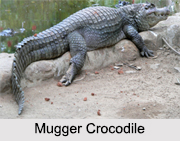 The Indian Subcontinent provides suitable habitats to various species of reptiles for residing and reproducing. Crocodiles are no exception in this regard. Saltwater Crocodile, Mugger Crocodile and Gharial are the three crocodiles which have been traced in India. These crocodiles are described below.
The Indian Subcontinent provides suitable habitats to various species of reptiles for residing and reproducing. Crocodiles are no exception in this regard. Saltwater Crocodile, Mugger Crocodile and Gharial are the three crocodiles which have been traced in India. These crocodiles are described below.
Saltwater Crocodile
 Saltwater Crocodile has rarely been sited on other parts of the Indian subcontinent, except the eastern coast of India. More specifically, they occupy brackish and freshwater regions. This species is the largest of all crocodilians and the largest reptile in the world reaching a more general length of about 5 to 6 meters, although the female crocodile attains a maximum length of about 2.5 to 3 meters. Saltwater Crocodile has a comparatively very large head, wide snout and fewer armor plates on its neck. A pair of ridges runs from the eyes along the centre of the snout. The adult crocodile has a broad body and usually appears dark greenish-drab, with lighter tan or grey areas. There are dark bands and stripes present on the lower flanks. It has creamy yellow to white underside, which turns grayer along the tail. The tail is grey in color and has dark bands. It is important to note that Saltwater Crocodiles do not maintain uniformity in color. Some adults may be visible in fairly pale skin, whereas others may appear blackish.
Saltwater Crocodile has rarely been sited on other parts of the Indian subcontinent, except the eastern coast of India. More specifically, they occupy brackish and freshwater regions. This species is the largest of all crocodilians and the largest reptile in the world reaching a more general length of about 5 to 6 meters, although the female crocodile attains a maximum length of about 2.5 to 3 meters. Saltwater Crocodile has a comparatively very large head, wide snout and fewer armor plates on its neck. A pair of ridges runs from the eyes along the centre of the snout. The adult crocodile has a broad body and usually appears dark greenish-drab, with lighter tan or grey areas. There are dark bands and stripes present on the lower flanks. It has creamy yellow to white underside, which turns grayer along the tail. The tail is grey in color and has dark bands. It is important to note that Saltwater Crocodiles do not maintain uniformity in color. Some adults may be visible in fairly pale skin, whereas others may appear blackish.
Mugger Crocodile
Mugger Crocodile is regionally widespread in the Indian Subcontinent. It is the most common and widespread of the three species of crocodiles found in India. The adult Mugger has blackish olive upper body. It has a rough head, which is devoid of ridges. Its eye is protected by a clear third eyelid. It has a broad snout and 19 upper teeth on each side. Its four large nuchals forms a square.  The dorsal shield is well separated from the nuchal. Scales on the limbs are keeled. There is a serrated fringe on the outer edge of the leg. This crocodile has webbed feet and a tail flat.
The dorsal shield is well separated from the nuchal. Scales on the limbs are keeled. There is a serrated fringe on the outer edge of the leg. This crocodile has webbed feet and a tail flat.
Gharial
Gharial is native to the northern part of the Indian Subcontinent. It is a critically endangered species, which can be comprehended from its distribution being limited to only 2% of its former range. This crocodile is known for its distinctively long and narrow snout, which is lined by 110 sharp interdigitated teeth. Its neck is elongated and thick. It has dark or light olive upper body. There are dark cross-bands and speckling on the head, body and tail. Its legs are relatively weak and the tail is well-developed and laterally flattened. Gharials are the only surviving crocodilian exhibiting sexual dimorphism.











